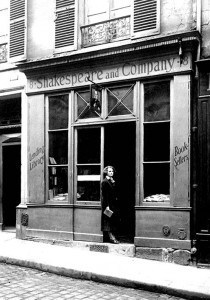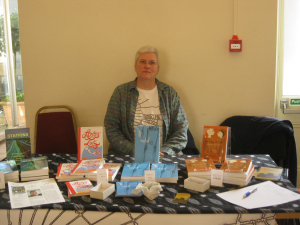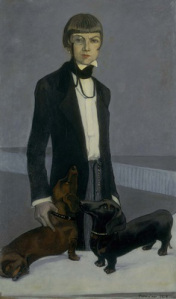Cherry Potts's Blog, page 14
March 16, 2014
The Historical Birthday-Party March 14th
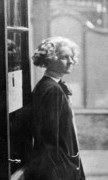 Sylvia Beach was born on March 14, 1887 in America. She studied French Literature at the Sorbonne in 1917, discovered a bookshop La Maison des Amis des Livres and fell in love with its proprietor Adrienne Monnier and lived with her for the rest of her life, apart from when she was interned during WWII.
Sylvia Beach was born on March 14, 1887 in America. She studied French Literature at the Sorbonne in 1917, discovered a bookshop La Maison des Amis des Livres and fell in love with its proprietor Adrienne Monnier and lived with her for the rest of her life, apart from when she was interned during WWII.
Sylvia opened her own bookshop in 1919, the famous Shakespeare and Company. Two years later she moved premises so that her shop was opposite Adrienne’s.
Sylvia’s paid for James Joyce’s novel Ulysses to be published, but when he got a contract from Random House, he forgot all about her.
During the 30′s the shop struggled and friends helped Sylvia out with subscriptions and benefit readings. In 1937, Sylvia was awarded a Knight of the Legion of Honor.
Sylvia stayed in Paris during the war. She was constantly threatened by the Gestapo, and eventually she packed all the books up and hid them in her apartment. In September 1942 she was interned, first at the Paris Zoo, and then at Vittel. She was eventually released, but after the war the bookshop did not reopen. Sylvia stayed in Paris until her death in 1962.
Sylvia definitely gets an invitation to the party, we could talk books til the morning…


Live from TLW LEXiCON
A lovely sunny day in Faversham and Alix & I are womaning the stall for Arachne Press at LEXiCON in the Alexander Centre.
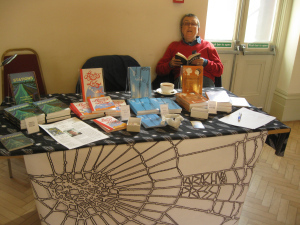
Alix at LEXiCON
I’m on stage later reading and taking part in a panel on cross genre writing. The timetable is a bit all over the place, but there’s something going on in the main room or in the performance space most of the day: turn up and be surprised, any time until 5pm.
There is a traditional sweet shop across the road, so I had to go and get some lovehearts to go with Lovers’ Lies, so they are decorating the books, and if you are quick I won’t have eaten them all!


March 14, 2014
The Historical Birthday-Tea Party March 13th
Today we raise a glass to Janet Flanner, March 13 1892 – November 7 1978.
 Janet was a journalist, writing for the New Yorker, and as a war correspondent. She lived in Greenwich Village and there met and fell in love with Solita Solano (Sarah Wilkinson). Janet and Solita featured as Nip and Tuck, a pair of journalists in Djuna Barnes’s Ladies Almanac (1928). During this time she wrote her novel The Cubical City.
Janet was a journalist, writing for the New Yorker, and as a war correspondent. She lived in Greenwich Village and there met and fell in love with Solita Solano (Sarah Wilkinson). Janet and Solita featured as Nip and Tuck, a pair of journalists in Djuna Barnes’s Ladies Almanac (1928). During this time she wrote her novel The Cubical City.
Although she loved Greenwich Village Janet wanted to get out of the city and eventually ended up in Paris, where they became friends with Natalie Barney, Gertrude Stein and many other ex-pat American Lesbians. Janet sent articles to the New Yorker from Paris under the pseudonym Genêt, and later from London.
When war broke out they moved back to New York and Janet met Natalia Murray, fell in love and moved in with her, helping her raise her son. This did not put an end to her relationship with Solita.
After the war Janet returned to Europe and Solita, covering the war trials, and the devastation the war had left behind. When Solita died, she moved back to America and to Natalia, and when she died, her and Natalia’s ashes were scattered together where they had first met.


The Historical Birthday-Tea Party March 12th
If not a fellow traveller, today’s birthday belongs to someone who was definitely and definitively a traveller .
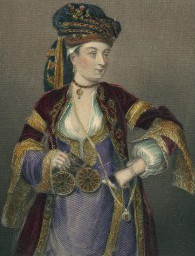 Hester Stanhope 12 March 1776 – 23 June 1839.
Hester Stanhope 12 March 1776 – 23 June 1839.
Hester was delightfully eccentric. She moved from being hostess for her uncle, Prime Minister William Pitt the younger, via a dramatic shipwreck at Rhodes, to become an archaeologist, the first to use documentary evidence to plan her dig, and to use what we now recognise as modern archaeological methods – not just ransacking a site for its treasures.
That shipwreck allegedly left her in need of clothes and she ended up dressed in male turkish clothing. Hester took to this form of attire and never went back to European or female dress. (seeing how dashing she looks in a turban one can see why.)
She behaved outrageously all over the Middle East, but somehow got away with it. (Unfortunately she’d been told by a fortune-teller that she would be the bride of a new messiah, and she took this seriously).
She settled in what is now the Lebanon, and became respected as a (rather annoying) force in the land. She eventually got into financial trouble, but stuck it out, dying in the home she had adopted.
Now would I want Hester at a party? I think so, provided she kept off her religious thing. She would have plenty of unlikely tales to amuse her fellow guests.


March 11, 2014
The Historical Birthday-Tea Party March 11th
Una Troubridge painted by Romaine Brooks
No particular birthday today, so going back to that 8th March that was choc-a-bloc, lets share cake with Una Troubridge 8 March 1887 – 24 September 1963.
At the tender age of ten Una lost her heart to a
splendaciously ample and properly upholstered principal boy… whose sex was never for a moment ambiguous … I sat in silent worship before the well filled silken tights … the dominant gait … the clustering curls … of this peerless wonder.
Una passed the entrance exam for art college at the age of 13 and was an accomplished sculptor. She married Admiral Troubridge and they had a daughter Andrea, who lived with Una when not at boarding school after their (acrimonious) separation.
Una met Radclyffe Hall (known as John, but more on her later) in 1915 while Una’s cousin Mabel Batten (aka Ladye) was John’s lover. Mabel died the following year, and Una and John moved in a year later.Una described her relationship with John as the first time she had known sexual rapture.
The couple had a wide circle of lesbian friends and thought that it was their duty to be visible, have no time for closeted lesbians (or gay men) who were financially independent and answerable to no one.
They had a lot of fun, partying with their friends, showing daschunds at Crufts and so on. On one occasion during a bicycling craze, John bought Una a bicycle which was christened Clara. Una insisted on a ‘loud and aggressive’ bell which she rang a great deal until John asked her to spare the neighbours.
Neither of them could be described as feminists, and Una saw her role as to make it as easy as possible for John to write, although she also wrote herself. She took on everything to do with the house, including supervising, with every sign of enjoyment, drainage works on their house in Rye, for which she dressed in a boiler suit.
They lived together until John died, in her arms, in 1943.
Una of John:
I could not, having come to know her, imagine life without her.
Una had John’s suits altered after her death and wore them herself.
Una died in 1963 in Rome, she had wanted to be buried with John and Mabel in Highgate cemetery but her instructions were not found until too late.
her tombstone describes her as
The friend of Radclyffe Hall


March 10, 2014
The Historical Birthday-Tea Party March 10th
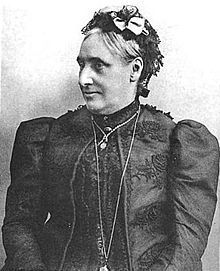 We’re going back to one of our birthday girls for the 8th March today:
We’re going back to one of our birthday girls for the 8th March today:
Louisa M Hubbard 8 March 1836 – 5 November 1906.
Louisa was a tireless and practical woman who put her back into creating opportunities for women. She did not do so for political reasons, and made a lot of effort not to appear political. She started out in the Anglican Deaconess movement, which could be thought of as an early precursor of the movement for female clergy though I doubt Louisa would have thought so) publishing a pamphlet Anglican Deaconesses; or Is There No Place for Women in the Parochial System?
Disappointed at lack of progress in the Deaconess movement she set up a training college for women elementary teachers, set up periodicals A Handbook for Women’s Work, (later The Englishwoman’s Yearbook) and The Woman’s Gazette, (later Work and Leisure) and wrote articles to dispel the stigma of (middle class and genteel) women working, arguing that it did not make a woman less marriageable, and that single women needed to be able to support themselves, and should not be seen as failures for not getting married. At the time she got going, the only real option for single middle class women without means of their own, was to work as a governess or a companion. She encouraged women into all kinds of work that she thought suitable, nursing, midwifery, teaching, setting up friendly societies and guilds to help women support each other.
She also recognised that work alone was insufficient, that for women to be independent they needed affordable safe housing, setting up the Ladies Dwelling Co.
Louisa also set up the Women’s Emigration Society. Women were actively discouraged from emigrating to British colonies, and Louisa felt that they were missing out on opportunities that men were encouraged to pursue. However the fact that emigration was promoted as a way to get a husband, leaves me ambivalent about this area of her work.
Louisa was clearly a very pragmatic person – see a problem, set about fixing it – she wasn’t one to snipe from a corner and complain that THEY ought to do something about it. By the end of her life much of the social stigma faced by middle class women who needed to work was gone, and she played a major role it making it possible for them to make a living.
An invitation to the party would obviously be sent, but I suspect Louisa would be in the kitchen making sure everything ran smoothly rather than tucking into cucumber sandwiches and a small sherry.


Vocal Chords on Radio3
Listen to me talking about our lovely choir, Vocal Chords, with us singing too… on iPlayer: Radio3′s The Choir, 0n until Sunday 16th March. We’re about 32 mins in.


March 9, 2014
The Historical Birthday-Tea Party March 9th
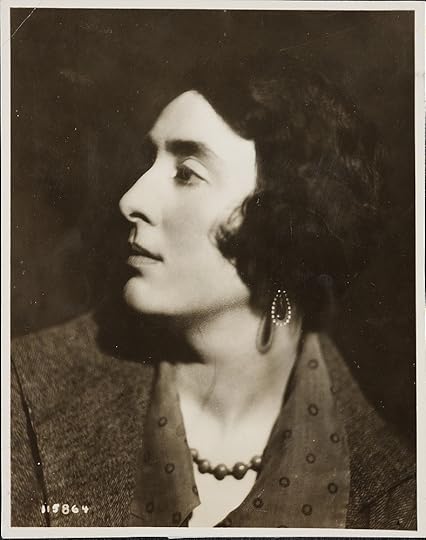 Raise your glasses, it’s the birthday of
Raise your glasses, it’s the birthday of
Vita Sackville-West
9 March 1892 – 2 June 1962 writer, gardener and serial womaniser.
Vita’s relationship with Violet Keppel (later Trefusis) is detailed in Portrait of A Marriage, by her son Nigel Nicholson. They met at school and at one point eloped to France. In her autobiography Violet said of Vita that when they met again for the first time after school
No one had told me that Vita had turned into a beauty. The knobs and knuckles had all disappeared. She was tall and graceful. The profound, hereditary Sackville eyes were as pools from which the morning mists had lifted.
Vita on Violet:
I go down country lanes and meet a sign saying: Beware, unexploded bomb. So I have to go around another way. You are the unexploded bomb to me. You gave me a coal black briquet. It lights up in the flame of love which burns in my heart whenever I think of you. You said it would last for three months, but our love has lasted forty years.
This was not Vita’s only high-profile affair, she also had a long relationship with Virginia Woolf. However she started young and kept at it, her first lover was Rosamund Grosvenor, another school friend,
I don’t remember very clearly, but the fact remains that by the middle of that summer we were inseparable, and moreover were living on terms of the greatest possible intimacy…. Oh, I dare say I realized vaguely that I had no business to sleep with Rosamund, and I should certainly never have allowed anyone to find it out, but my sense of guilt went no further than that.
Others Vita had affairs with were Muriel Clark-Kerr, Mary Garman,(who wrote of Virginia’s book Orlando
Vita darling you have been so much Orlando to me that how can I help absolutely understanding and loving the book… Through all the slight mockery which is always in the tone of Virginia’s voice, and the analysis etc., Orlando is written by someone who loves you so obviously.)
The list continues: Journalist Evelyn Irons and Hilda Matheson of the BBC. Most of Vita’s affairs were long-lived and she was often keeping more than one lover on her string. She was not averse to flirtations: she kissed Christabel Gertrude Marshall ( known as Christopher St John, lover of Edy Craig) behind Sevenoaks station, and Chris was ‘never the same again.’
I’d be a bit nervous of having Vita to a party, there’s no telling who she’d leave with, but she is magnificently unapologetic, and quite aside from her romantic shenanigins, an innovative gardener and her novels aren’t bad either, I’ve read All Passion Spent and The Easter Party and enjoyed them. So an invitation will go out, but with a secret hope that Ms Sackville-West might decline.


March 8, 2014
The Historical Birthday-Tea Party March 8th
International Women’s Day, and I have three birthday girls to choose from. So I’m going with the oldest, and we can catch up with the others later.
Anne Bonny, 8 March 1702 – 22 April 1782 born in Ireland, emigrated to America at a young age, where her father did very well for himself. Anne was a tear away, hotheaded, handy with a knife and married a small-time pirate. her father disowned her, and she and her husband went to Nassau where all the pirates hung out. Anne there met and started a relationship with Jack Rackham, and had a child with him. She abandoned the child, divorced her husband and set about being a ‘proper’ pirate. She was friends with Mary Read, and they were captured together with Rackham after stealing a ship together (The men were all drunk and Mary and Anne were the only ones to put up a fight) they were all sentenced to hang. (Anne’s last words to her lover were, had you fought like a man, you needn’t be hang’d like a dog) The women got off by claiming pregnancy, but Mary died of a fever, and Anne escaped, possibly with the connivance of her father, and lived to a ripe and respectable old age.


March 7, 2014
The Historical Birthday-Tea Party March 7th
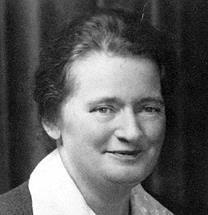 Today’s birthday girl is Lorena Hickok March 7, 1893 – May 1, 1968 known as ‘Hick’.
Today’s birthday girl is Lorena Hickok March 7, 1893 – May 1, 1968 known as ‘Hick’.
Hick was a journalist, working in the 1920s on the Minneapolis Tribune when she met and lived with fellow reporter Ella Morse for six years.
The combination of Hick’s diabetes and Ella’s elopement with an ex-boyfriend lead to Hick’s move to New York and in 1928 a job with Associated Press where she was assigned some high-profile work at The New York Times for which she wrote under her own byline, the first woman to do so at that paper.
Following her being assigned to cover F D Roosevelt’s 1932 presidential election campaign, Hick became friends with his wife, Eleanor, travelled together, writing daily when apart, and made no bones of how they felt about each other. Not long into FDR’s first administration Hick left journalism, partly because she could not be unbiased, partly because it kept her apart from Eleanor. She landed a job for the Federal Emergency Relief Administration, but by 1937 Eleanor was withdrawing from the relationship.
Hick was very hurt, and again changed job, although she ended up living first at the White House. During this time she struck up an intimate friendship with female judge Marion Janet Harron. Hick and Eleanor continued to correspond and meet, and Hick subsequently moved to live near Hyde Park, the Roosevelt’s country retreat as her health declined. Around 3000 intimate, loving letters between Eleanor and Hick are now deposited in the US National Archives.
Hick, darling
Ah, how good it was to hear your voice. It was so inadequate to try and tell you what it meant. Funny was that I couldn’t say je t’aime and je t’adore as I longed to do, but always remember that I am saying it, that I go to sleep thinking of you.
Eleanor to Hick
Dear, I’ve been trying today to bring back your face…Most clearly I remember your eyes and the feeling of that soft spot just northeast of the corner of your mouth against my lips.
Hick to Eleanor



